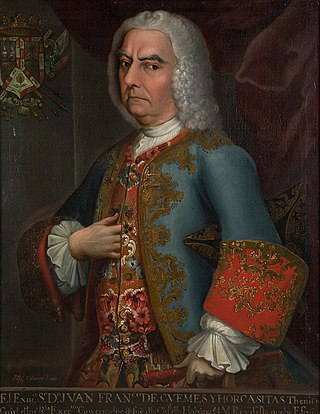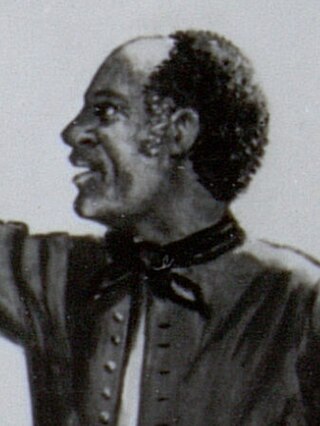
A presidio was a fortified base established by the Spanish Empire between the 16th and 18th centuries in areas under their control or influence. The term is derived from the Latin word praesidium meaning protection or defense.

Los Adaes was the capital of Tejas (Texas) on the northeastern frontier of New Spain from 1721 to 1773. It included a Franciscan mission, San Miguel de Cuéllar de los Adaes, and a presidio, Nuestra Señora del Pilar de Los Adaes. The name Adaes derives from the indigenous Adai people, members of the Caddoan confederacy of Indians who were the people the missionaries aimed to convert to Christianity. The presidio and mission were established to counter French influence in Louisiana territory and defend New Spain from possible invasion or encroachment by the French. In 1763 Louisiana came under the control of Spain and the Los Adaes outpost was no longer necessary for defense. In 1773 the Spanish closed the mission and presidio and forced the population to move to San Antonio.

Spanish Texas was one of the interior provinces of the colonial Viceroyalty of New Spain from 1519 until 1821. Spain claimed ownership of the region in 1519. Slave raids by Spaniards into what became Texas began in the 16th century and created an atmosphere of antagonism with Native Americans (Indians) which would cause endless difficulties for the Spanish in the future. Spain did not attempt to establish a permanent presence until after France established the colony of Fort Saint Louis in 1685. In 1688, the French colony failed due to internal dissention and attacks by the Karankawa Indians. In 1690, responding to fear of French encroachment, Spanish explorer Alonso de León escorted several Catholic missionaries to east Texas, where they established the first mission in Texas. That attempt to establish a Spanish colony failed due to the hostility of the Caddo Indians.

El Presidio Real de Santa Bárbara, also known as the Royal Presidio of Santa Barbara, is a former military installation in Santa Barbara, California, United States. The presidio was built by Spain in 1782, with the mission of defending the Second Military District in California. In modern times, the Presidio serves as a significant tourist attraction, museum and an active archaeological site as part of El Presidio de Santa Barbara State Historic Park.

The Villasur expedition of 1720 was a Spanish military expedition intended to check New France's growing influence on the North American Great Plains, led by Lieutenant-General Pedro de Villasur. Pawnee and Otoe Indians attacked the expedition in Nebraska, killing 36 of the 40 Spaniards, 10 of their Indian allies, and a French guide. The survivors retreated to their base in New Mexico.

The adarga was a hard leather shield created by the North African Berbers, its name derived from the Berber "adarga" meaning "oryx". An important center of manufacture of the adarga was the city of Fes, Morocco. The adarga was typically made from the hide of the antelope and was extremely resistant to the blows of sword, lance, javelin, and arrow, but other kinds of leather were used as well. Inside, in the center, was a pair of leather grips held in the hand or strapped to the forearm with a small cushion beneath to absorb impact. Originally the adarga was round, then heart shaped, then finally it took the form of a pair of overlapping ellipses or ovals, measuring 69–80 cm (27–31.5 in) in the long axis. Two or more layers of hide were glued and sewn together to make the adarga both rigid and elastic, and often decorated with incised and gilt ornaments, Moorish inscriptions, and metal appliques and borders.

Juan Francisco de Güemes y Horcasitas was a Spanish general, governor of Havana, captain general of Cuba, and viceroy of New Spain.

The Camino Real de Tierra Adentro, also known as the Silver Route, was a Spanish 2,560-kilometre-long (1,590 mi) road between Mexico City and San Juan Pueblo, New Mexico, that was used from 1598 to 1882. It was the northernmost of the four major "royal roads" that linked Mexico City to its major tributaries during and after the Spanish colonial era.

The Presidio Santa Cruz de Terrenate is a former Spanish military presidio, or fortress, located roughly west of the town of Tombstone, Arizona, in the United States of America.
Cayetano Maria Pignatelli Rubí Corbera y San Climent was a Spanish nobleman. Rubí was commissioned by the King Charles III of Spain to inspect the presidios on the northern frontier of New Spain and make recommendations to improve defense against raids by Indian tribes, especially the Apache. From 1766 to 1768, Rubí visited 23 presidios scattered from the Gulf of California to present-day Louisiana, traveling overland about 7,600 mi (12,200 km) in 23 months. He wrote a report on his travels which is a valuable source of information about conditions on New Spain's northern frontier. His recommendations, later implemented, were that Spain withdraw from some presidios on its far northern frontier, including Louisiana and eastern Texas, and strengthen others which were in a poor state of readiness. He recommended that San Antonio replace Los Adaes as the capital of Spanish Texas. To combat the Indian threat, he recommended an offensive war against the Apaches and an alliance with the Comanche to subdue the Apache.
Juan Francisco Reyes (1749–1809), soldado de cuera on the 1769 Portola expedition, alcalde of the Pueblo de Los Angeles for three terms, and recipient of the Spanish land grant for Rancho Los Encinos and later Lompoc.
The Berryessa family is a prominent Californio family of Northern California. Members of the family held extensive rancho grants across the Bay Area during 18th and 19th centuries. Numerous places are named after the family, including the Berryessa district of San Jose and Lake Berryessa in Napa County.

The First Battle of Terrenate on July 7, 1776 was a military engagement during the Spanish period of Arizona. It was fought between Spanish soldiers and Apache warriors, near the Presidio Santa Cruz de Terrenate in the present day southern Arizona.
Manuel de Sandoval was a prominent Neomexican soldier who served as governor of Coahuila and Texas (1734–1736). During his administration in Texas, he lived in and worked on the problems of Bexar, but he neglected Los Adaes, which was the capital of Texas and served to control French expansion and prevent it from reaching Texas. Under his administration, the French commander Louis Juchereau de St. Denis transferred a French presidio from Louisiana to Texas, which led to Sandoval being expelled from the government and replaced. Sandoval was accused of several charges linked his administration, which took him to prison and to pay a fine equivalent to 500 dollars.
Antonio Valverde y Cosío was the architect behind the disastrous Villasur expedition wherein the famous Spanish colonial scout José Naranjo perished.

Luis Manuel Quintero was a Afro-Spanish tailor from Guadalajara, Jalisco; who was one of the 44 original settlers of the Pueblo de Los Angeles on September 4, 1781.

The Presidio of San Sabá was the second presidio established at the site of present-day Menard, Texas on the San Saba River. The first was the Presidio San Luis de las Amarillas, established by Colonel Diego Ortiz Parrilla in April 1757, the same time that Mission Santa Cruz de San Sabá was also founded by Fr. Alonso Giraldo de Terreros some three miles downstream. Initially, both the presidio and mission were enclosed by a wooden stockade. About 2,000 Comanche and Wichita warriors attacked and destroyed the mission March 16, 1758, but did not attack the presidio. Colonel Parrilla led a punitive expedition against the hostiles about one year later, but was defeated in the Battle of the Twin Villages at a large Wichita village on the Red River. Colonel Parrilla was relieved of command as a consequence of this setback and replaced by Captain Felipe de Rábago y Terán.
Gaspar Domingo de Mendoza y Delgado was a Spanish soldier in the War of the Spanish Succession. He later served as the Spanish colonial governor of Santa Fe de Nuevo México province from 1739 to 1743, located in the northern Viceroyalty of New Spain.

The military of New Spain played an insignificant role during the 17th century. The new Mexican society growing on the ruins left by the conquest was peaceful. A very limited number of regular troops, a couple of companies, were enough to keep the peace. The defense against external enemies was based on a limited number of fortified port cities. Spanish conflicts with the British Empire during the 18th century changed this. The Bourbon Reforms resulted in the transfer of regular Spanish Army troops from Spain to New Spain, the raising several colonial line infantry regiments, and the creation of a colonial militia which also included former slaves. The northern frontier was the exception to the peacefulness of Mexico, with constant warfare with the nomadic Native Americans.














